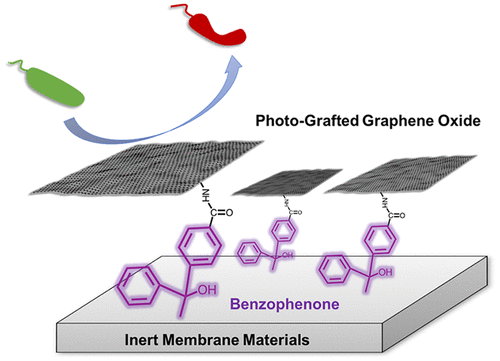当前位置:
X-MOL 学术
›
Environ. Sci. Technol. Lett.
›
论文详情
Our official English website, www.x-mol.net, welcomes your
feedback! (Note: you will need to create a separate account there.)
Photografting Graphene Oxide to Inert Membrane Materials to Impart Antibacterial Activity
Environmental Science & Technology Letters ( IF 8.9 ) Pub Date : 2019-02-08 , DOI: 10.1021/acs.estlett.9b00012 Masashi Kaneda 1, 2 , Xinglin Lu 1 , Wei Cheng 1, 3 , Xuechen Zhou 1 , Roy Bernstein 4 , Wei Zhang 4 , Katsuki Kimura 2 , Menachem Elimelech 1
Environmental Science & Technology Letters ( IF 8.9 ) Pub Date : 2019-02-08 , DOI: 10.1021/acs.estlett.9b00012 Masashi Kaneda 1, 2 , Xinglin Lu 1 , Wei Cheng 1, 3 , Xuechen Zhou 1 , Roy Bernstein 4 , Wei Zhang 4 , Katsuki Kimura 2 , Menachem Elimelech 1
Affiliation

|
Surface modification with bactericides is a promising approach to imparting membrane materials with biofouling resistance. However, chemical modification of membranes made from inert materials, such as polyvinylidene fluoride (PVDF) and polysulfone, is challenging because of the absence of reactive functional groups on these materials. In this study, we develop a facile procedure using benzophenone as an anchor to graft biocidal graphene oxide (GO) to chemically inactive membrane materials. GO nanosheets are first functionalized with benzophenone through an amide coupling reaction. Then, benzophenone-functionalized GO nanosheets are irreversibly grafted to the inert membrane surfaces via benzophenone-initiated cross-linking under ultraviolet irradiation. The binding of GO to the membrane surface is confirmed by scanning electron microscopy and Raman spectroscopy. When exposed to a model bacterium (Escherichia coli), GO-functionalized PVDF and polysulfone membranes exhibit strong antibacterial activity, reducing the number of viable cells by 90% and 75%, respectively, compared to the number with the pristine membranes. Notably, this bactericidal effect is imparted to the membranes without compromising membrane permeability or solute retention properties. Our results highlight the potential application of benzophenone chemistry in membrane surface modification as well as its promise in developing antimicrobial surfaces for a variety of environmental applications.
中文翻译:

光接枝氧化石墨烯惰性膜材料赋予抗菌活性
用杀菌剂进行表面修饰是使膜材料具有抗生物污垢性的一种有前途的方法。但是,由惰性材料(例如聚偏二氟乙烯(PVDF)和聚砜)制成的膜的化学改性面临挑战,因为这些材料上没有反应性官能团。在这项研究中,我们开发了一种简单的方法,使用二苯甲酮作为锚定,将杀生物性氧化石墨烯(GO)嫁接到化学惰性的膜材料上。GO纳米片首先通过酰胺偶联反应用二苯甲酮官能化。然后,将二苯甲酮官能化的GO纳米片通过二苯甲酮引发的紫外线交联不可逆地接枝到惰性膜表面。GO与膜表面的结合通过扫描电子显微镜和拉曼光谱法确认。当暴露于模型细菌(大肠杆菌,GO功能化的PVDF和聚砜膜均显示出强大的抗菌活性,与原始膜相比,其存活细胞数分别减少了90%和75%。值得注意的是,这种杀菌作用被赋予了膜而没有损害膜的渗透性或溶质保留性能。我们的结果突出了二苯甲酮化学在膜表面改性中的潜在应用以及在开发用于各种环境应用的抗菌表面方面的前景。
更新日期:2019-02-08
中文翻译:

光接枝氧化石墨烯惰性膜材料赋予抗菌活性
用杀菌剂进行表面修饰是使膜材料具有抗生物污垢性的一种有前途的方法。但是,由惰性材料(例如聚偏二氟乙烯(PVDF)和聚砜)制成的膜的化学改性面临挑战,因为这些材料上没有反应性官能团。在这项研究中,我们开发了一种简单的方法,使用二苯甲酮作为锚定,将杀生物性氧化石墨烯(GO)嫁接到化学惰性的膜材料上。GO纳米片首先通过酰胺偶联反应用二苯甲酮官能化。然后,将二苯甲酮官能化的GO纳米片通过二苯甲酮引发的紫外线交联不可逆地接枝到惰性膜表面。GO与膜表面的结合通过扫描电子显微镜和拉曼光谱法确认。当暴露于模型细菌(大肠杆菌,GO功能化的PVDF和聚砜膜均显示出强大的抗菌活性,与原始膜相比,其存活细胞数分别减少了90%和75%。值得注意的是,这种杀菌作用被赋予了膜而没有损害膜的渗透性或溶质保留性能。我们的结果突出了二苯甲酮化学在膜表面改性中的潜在应用以及在开发用于各种环境应用的抗菌表面方面的前景。











































 京公网安备 11010802027423号
京公网安备 11010802027423号